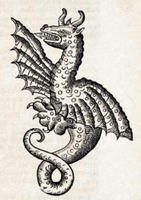

One of the most interesting elements associated with the evoluton of science as a logical discipline is observing its rise from the dark ages notion of fantastical beliefs; whether in astronomy or chemistry or, as here, with natural science/biology.


The sample of woodcut images displayed unfairly suggests that the book from which they came leaned toward the mythical over the living. That's not the case. The apparent slant is merely a product of my affinity for the unusual. If it weren't for the conjured species I would doubtless have passed over it entirely. But there is quite a bit of stylizing in depicting the real creatures that makes the set all the more interesting as a whole.
 Su : "A wild beast from Patagonia that has a broad tail and carries its young on its back. It is described by Topsell as a "cruell, untameable, impatient, violent, ravening, and bloody beast." When it sees hunters coming after it, "she roareth, cryeth, howleth, brayeth, and uttereth such a fearefull, noysome, and terrible clamor that the men which watch to kill her are not thereby a little amazed."
Su : "A wild beast from Patagonia that has a broad tail and carries its young on its back. It is described by Topsell as a "cruell, untameable, impatient, violent, ravening, and bloody beast." When it sees hunters coming after it, "she roareth, cryeth, howleth, brayeth, and uttereth such a fearefull, noysome, and terrible clamor that the men which watch to kill her are not thereby a little amazed." It's a little tricky identifying just when these images were created or under whose authorship they were first published. But they were scanned from a book called The History of Four-Footed Beasts and Serpents which was published in 1658 - from the first 2 volumes of a 3 volume set edited by John Rowland. The original version of The History.. was published by Edward Topsell in 1607 as The Historie of Foure-Footed Beastes, Describing the True and Lively Figure of Every Beast. He further published The Historie of Serpents; Or the Second Booke of Living Creatures the following year.
But these works by Topsell were not entirely original as they were based on a 5-volume publication by Conrad Gesner in the mid 1500s - Historiae Animalium. The woodcuts themselves were lifted straight from Gesner's book. But despite deference to prior beliefs by including imaginary beings, the book(s) try to follow a line of reasoning in describing their subject matter. (Scan of the first page of the 1658 edition) Aristotle and Pliny the Elder were major sources.


The Special Collections department of the University of Huston Libraries have an exhibit of 175 scans from the 1658 Rowland book, noting where known both the original and modern name of the creature portrayed. It is very comprehensive for what must have been known of the naturual world at the time.
Addit: This 4-page site doesn't seem at all authoratative but there is some further commentary taken from the book.




No comments:
Post a Comment